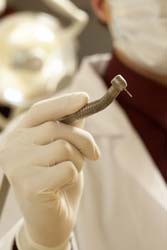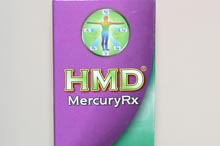Heavy Metal Toxicity: Signs and Symptoms That You May be Toxic
by www.SixWise.com
Over the past 50 years human exposure to heavy metal toxins has risen dramatically. Each day we are exposed to some kind of heavy metal toxin whether it is the air, the water we drink or the food we eat.
|

Silver dental fillings are one major route of exposure to heavy metals such as mercury.
|
Chronic exposure to these dangerous toxins come from the mercury-amalgam fillings we get from our dental visits, lead in paint and tap water, chemical residues found in processed foods and toxins in personal care products, among others.
Certain professions are also at higher risk for mercury exposure including anyone in the dental occupation, laboratory workers, hairdressers, painters, printers, welders, metalworkers, cosmetic workers, battery makers, engravers, photographers, visual artists and potters.
While some people have the ability to excrete these toxins out of their system, others, particularly those suffering from chronic conditions, are not so lucky and develop a build-up of metals called heavy metal toxicity. Further, heavy metals can accumulate in your body over time, causing symptoms you might not equate with heavy metals.
In many cases, the symptoms brought on by metal toxicity are often misdiagnosed for chronic conditions such as autism, chronic fatigue syndrome, depression and multiple sclerosis.
Symptoms of Heavy Metal Toxicity
There are two types of heavy metal toxicity: acute and chronic. Symptoms of acute toxicity are easy to recognize because they are usually quick and severe in onset. The symptoms include:
-
Cramping, nausea, and vomiting
-
Pain
-
Sweating
-
Headaches
-
Difficulty breathing
-
Impaired cognitive, motor, and language skills
-
Mania
-
Convulsions
Chronic exposure, on the other hand, produces different symptoms, which can be easily confused with symptoms of different illnesses. Some of the symptoms are impaired cognitive, motor, and language skills, learning difficulties, nervousness and emotional instability, insomnia and nausea.
In fact, because toxic metals block the absorption and utilization of essential minerals, this in itself can set up a whole cascade of symptoms that gradually get worse over time.
Below is a more specific checklist of symptoms of metal toxicity poisoning:
-
Chronic pain throughout the muscles and tendons or any soft tissues of the body
-
Chronic malaise -- general feeling of discomfort, fatigue, and illness
-
Brain fog -- state of forgetfulness and confusion
-
Chronic infections such as Candida
-
Gastrointestinal complaints, such as diarrhea, constipation, bloating, gas, heartburn, and indigestion
-
Food allergies
-
Dizziness
-
Migraines and/or headaches
-
Visual disturbances
-
Mood swings, depression, and/or anxiety
-
Nervous system malfunctions -- burning extremities, numbness, tingling, paralysis, and/or an electrifying feeling throughout the body
Arsenic, Lead and Mercury: A Potentially Deadly Heavy Metal Toxin Combination
The most common heavy metals that can be harmful to your health in large amounts are aluminum, cadmium, arsenic, lead, and mercury with the last three contributing to the most cases of heavy metal toxicity.
The Agency for Toxic Substances and Disease Registry (ATSDR) confirmed this when they compiled a Priority List for 2001 called the "Top 20 Hazardous Substances." The first three heavy metals to appear on their list were arsenic, lead and mercury.
Heavy Metal Toxicity -- Dr. B.J. Hardick's own story
Arsenic
According to the ATSDR, arsenic is considered the most common cause of heavy metal poisoning. Humans are exposed through environmental pollution (arsenic is released from the smelting process of copper, zinc and lead and through the manufacturing of chemicals and glass), ingestion (found in insect poisons), skin contact (some linseed oils) and our worldwide water supply, which has contaminated shellfish, cod and haddock that are later eaten.
An arsenic-based additive is also used in chicken feed to promote growth, kill parasites and improve pigmentation of chicken meat. So if you eat commercial, non-organic chicken you can also be exposed to arsenic through the meat.
Some other sources include paints, rat poison, fungicides, and wood preservatives. Arsenic targets specific organs such as the blood, kidneys, central nervous system and skin systems.
Symptoms of arsenic metal toxicity include:
Arsenic metal toxicity precautions you can take:
-
Maintain a high-fiber diet -- Fiber binds with arsenic to eliminate it from your body
-
Eat foods high in sulfur such as eggs, onions, beans, legumes, and garlic -- Sulfur helps get rid of arsenic in your body
Lead
Lead is listed as number two on the ATSDR's "Top 20 List” and is behind most of the cases of pediatric heavy metal poisoning. Lead is a very soft metal that was used in pipes, drains, and soldering materials in the construction of millions of homes built before 1940. Chronic exposure results from weathering, flaking, chalking, and dust.
Approximately 2.5 million tons of lead is also produced throughout the world each year for batteries, cable coverings, plumbing, ammunition and fuel additives, paint pigments and use in PVC plastics, x-ray shielding, crystal glass production, and pesticides.
Nearly half a million U.S. children between the ages of 1 and 5 have blood lead levels greater than the CDC recommended level of 10 micrograms of lead per deciliter of blood, according to the CDC.
The heavy metal toxicity of lead targets the bones, brain, blood, kidneys and thyroid gland and can affect the nervous system, gastrointestinal system, cardiovascular system, blood production, and reproductive system.
Lead poisoning precautions you can take:
-
A surefire way to know whether or not you’re being exposed to lead is to have your home tested. This is crucial if your home was built before 1978, when lead-based paints were used in homes. If you get back positive results on your home, you can contact a reputable company to remove it.
-
Be very careful if you partake in hobbies you are likely to come in contact with lead such as stained glass window work.
-
Use glassware for drinking or eating instead of ceramic-ware if you are unsure if they contain lead-based paints and glazes
Symptoms of lead poisoning include:
-
Gastrointestinal complaints
-
Hypertension
-
Fatigue
-
Abdominal pain
-
Nausea
-
Constipation
-
Weight loss
-
Peripheral neuropathy
-
Cognitive dysfunction
-
Headache
-
Weakness
-
Convulsions
-
Impotence or loss of libido
-
Depression of thyroid and adrenal function, chronic renal failure, gout
-
Mental symptoms include restlessness, insomnia, irritability, confusion, excitement, anxiety, delusions, and disturbing dreams
Mercury
Mercury ranks number three on ATSDR's "Top 20 List”. Mercury is naturally transmitted into the environment from volcanic emissions that come from the degassing of the earth’s crust. There are three forms of mercury: elemental, organic and inorganic.
Mercury has found its way into the aquatic food chains and fish through being dispersed into the atmosphere by winds, returning to the earth in rainfall and finding its way into the water. Mercury compounds continue to be used in medicines such as mercurochrome and merthiolate, algaecides and certain vaccines. Another route to exposure is through inhalation, targeting the brain and kidneys.
Another route of mercury exposure is via dental amalgams, which include mercury. In one Norwegian study, 47 percent of patients with dental amalgam fillings reported suffering from major depression -- a symptoms of metal toxicity -- compared with only 14 percent in the control group.
And another study, published in Neuroendocrinology Letters, found that removal of mercury fillings resulted in improvements in 70 percent of those who suffered from mercury-related health problems like depression.
Mercury has also recently been found to contaminate many sources of high-fructose corn syrup.
Mercury toxicity symptoms:
-
Metallic taste in the mouth
-
Excess salivation
-
Gingivitis
-
Tremors
-
Stomach and kidney troubles
-
Mental symptoms include shyness, irritability, apathy and depression, psychosis, mental deterioration, and anorexia
Mercury toxicity precautions you can take:
-
Stay away from amalgam (silver) fillings, look into a holistic dentist that practices mercury-free dentistry
-
If you already have “silver” fillings, look into a mercury-free dentist who specializes in the safe removal of mercury amalgams
-
Sit down with your doctor and discuss the use of vaccines, particularly the ones that contain thimerosal, a mercury preservative linked to autism, behavioral, and learning disorders in children
-
Purchase thermometers without mercury to avoid toxic spills in the event of breakage
-
Avoid eating bottom crawler seafood and deep-sea fish that contain high levels of mercury such as oysters, clams and lobster, tuna, mackerel and swordfish
Treatment and Prevention of Heavy Metal Toxicity
There are two important steps to take in the treatment of heavy metal toxicity in your body -- identifying the toxin and then removing it from your system.
One way to identify the metal(s) in your body is through chelation treatments, which involve using chelating drugs along with 24-hour urine collection that is later tested for metals. These tests are expensive and invasive. A better test that is simple and can give a lot of information about the levels of essential minerals as well as toxic metals in circulation in your blood is using Hair Tissue Mineral Analysis.
|

Remove Heavy Metals From Your Body Safely and Naturally With HMD
HMD™ (Heavy Metal Detox) from DrHMD.com is a unique natural oral formula that helps to effectively eliminate heavy metals from your and your child’s bodies, without any side effects.
Even if you’re not currently suffering symptoms of heavy metal poisoning, it is still highly recommended that you and your children use HMD™ as a preventative, as nearly everyone living on this planet is affected by heavy metals in some way or another. It's in the air we breath, the water we drink, the food we eat (fish), in our teeth (silver dental filings), in vaccinations (thimerosol and aluminium), and in various household furniture and bedding that we use every day.

Learn More and
Order HMD Now!
|
There are many ways of removing toxic metals from the body, but most of them involve expensive treatments where a doctor has to inject drugs or vitamins intravenously into your body via a drip. A lot of these drugs will also strip the good minerals from your body, something that is not recommended.
A simpler way is to take a few drops of a natural tincture a few times per day -- it simply goes into water or some juice. This is the beauty of using HMD.™
If you suspect heavy metals have already accumulated in your body from silver dental fillings, contaminated seafood and other foods, cosmetics, pollution, contaminated water and other sources it would be wise to disarm this potential “time-bomb” now before it potentially causes serious illness or death.
At Sixwise we highly recommend that you use HMD™ (Heavy Metal Detox), a natural oral formula that helps to effectively eliminate heavy metals from your body, without any side effects.
HMD™ is actually the ONLY chelator that has undergone a $1 million, three-year double-blind placebo-controlled research trials with several hundred people! During these three years over 25 different natural products and combinations were tried but the synergistic components of HMD™ were the only ones that worked for all metals tested. It presently has a worldwide patent-pending.
Dr. George John Georgiou -- HMD™ Inventor and worldwide Patent holder -- has 9 degrees and diplomas, including two doctorates and has been researching natural heavy metal chelators for a number of years, after he discovered that he became ill himself with mercury poisoning after replacing 12 amalgam fillings with composites.
After a number of years of searching, Dr. Georgiou discovered a unique synergistic formula comprising three natural components: Chlorella Growth Factor, Cilantro or the herb Coriandrum sativum and a homaccord of Chlorella. None of these natural products worked when tested individually, but when combined there was a “magic” synergy that eliminated a large number of toxic metals, including the ones mentioned here.
It is not only a very powerful chelator of toxic metals, but a very gentle one too. It has been tried and tested in many people worldwide, including children with autism, with no side effects when used at the correct dosage. It has therefore been dubbed “The Gentle Chelator.”
A great combination with HMD™ in reducing your risk of heavy metal toxicity is taking control of what you eat and creating an overall healthy lifestyle that reduces your exposure to heavy metals in the first place.
The following are healthy diet guidelines you can follow to achieve a toxin-free (or as close to it as possible) life.
-
Add antioxidant-rich foods to your diet to build a wall against metal toxicity:
-
Vitamin C: Citrus fruits (oranges, grapefruit, tangerines)
-
Vitamin E: Sprouted nuts and seeds, fish oil
-
Beta carotene: Carrots, sweet potatoes, peaches, apricots
-
Fill your diet with foods rich in zinc -- red meat, beans, and dairy products -- and magnesium -- broccoli, spinach, Swiss chard, and pumpkin seeds
-
Eat a high-fiber diet by adding ground flax meal to promote regularity in your digestive functioning
-
Incorporate foods that are rich in omega-3 essential fatty acids--ground flax meal, wild-caught salmon, low-mercury fish, avocados, fish oil and sprouted walnuts
-
Add fresh cilantro to your meals to help mobilize mercury and other neurotoxic metals
- Make your own healthy raw food recipes. The staff at Sixwise.com truly enjoys the recipes in Alive in 5: Raw Gourmet Meals in 5 Minutes to help keep their families eating healthy.
Acclaimed raw chef Angela Elliott shows how to whip up mouth-watering lasagna, spaghetti marinara, stuffed mushrooms, broccoli in cheese sauce, apple pie, decadent whipped cream and strawberries, chocolate shake, and more -- all in about five minutes, with easy-to-find ingredients and just a blender or food processor.
According to the EPA, children who eat healthy diets absorb less lead, so this may potentially hold true for other metals as well.
Of course, the key to avoiding heavy metals in your foods lies to some extent in choosing your food with care -- although toxins are so ubiquitous nowadays that it may be impossible to avoid them completely.
As it stands, the best way to ensure that the food you eat is as safe and healthy as possible is to educate yourself about potential contaminants -- and avoid those foods.
Eating organic produce, meats and other foods, or those you know have been grown locally with care, will also go a long way toward reducing your exposure to these toxins. If you don't have access to organic foods, you can reduce your exposure to one type of toxin, pesticides, by avoiding the most-contaminated produce listed in this article.
If you’re worried that you may already have accumulated metals in your body, certain supplements such as chlorella (a type of green algae) and green or red clay may help you to detoxify along with HMD.
Recommended Reading
How to Remove Toxins From Your Home and Other Natural Cleaning Tips
Are Metals in Food Harming Your Child’s Behavior?
Sources
Becomehealthynow.com
Diagnoseme.com
Life Extension
ScienceDaily April 10, 2007